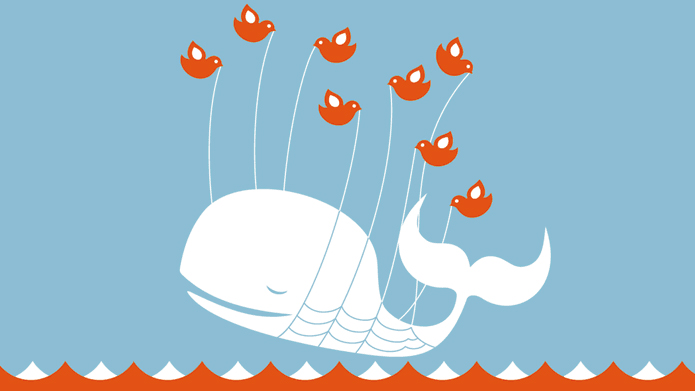Twitter's crown has slipped, but is it too big to fail?
User growth has stalled, and Wall Street isn't happy about it

10 years is a long time in Silicon Valley, but Twitter is a service that is, in many ways, still finding its feet. In the space of a decade the little blue bird has amassed 320 million active users and transformed into a globally recognised brand. Yet, what Twitter is and what Twitter wants to be aren't necessarily aligned, and on its 10th birthday the question of whether its best days are behind or ahead of it is difficult to answer.
Twitter is about the now, the immediate, but how Twitter presents the "immediate" and what it does with that information is arguably not where it needs to be.
Earlier this year, company CFO Anthony Noto admitted Twitter had "only reached early adopters and techies", with some way to go before it hits the "mass market" - which is also where investors want it to be. As EIC Darren Murph previously highlighted, investors would like Twitter to turn itself into Wall Street darling Facebook - 1.6 Billion users strong - and recently-returned CEO Jack Dorsey is clearly feeling the pressure to respond.
When Twitter users hear of dramatic changes, from breaking out of the 140-character limit (recently denied by Dorsey) to reshuffling the chronological timeline (which happened, but not as dramatically as it was originally reported), the outcry speaks volumes. Twitter's central tenets are quite simple, and any slight tip of the balance is felt dramatically. Investors want Twitter to be Facebook, users want it to stay Twitter.
As revenue continues to grow strong year-on-year, Twitter's certainly not gasping for air, but it's also spending a lot of money, stock has tanked, and user growth has slowed dramatically. There is also a large number of lapsed users that Twitter is trying to win back, and Wall Street is more focused on these negatives.
"People are turning away because they can't deal with the volume of data," says Gerry Brown, Software Research Director at IDC Europe. "What is the place for Twitter in the modern day? If I talk to my friends about it, most of them don't use Twitter anymore because they see it as a source of spam."
Sound off
Twitter knows that it has a noise problem and has tried to combat this by making it easier for users to seek out the signals. Most recently, it introduced a new feature that puts "missed" tweets to the top of our timelines; Moments was another new tool for helping users follow breaking news, but it hasn't yet caused a massive uptick in user re-engagement.
Get daily insight, inspiration and deals in your inbox
Sign up for breaking news, reviews, opinion, top tech deals, and more.
Meanwhile, Twitter has acquired video services Vine and Periscope, but its overall portfolio remains of meagre compared to other Silicon Valley titans. Facebook, Instagram and others have pushed hard into video in their own, perhaps more effective, ways. "To me their product portfolio is one dimensional," says Brown. "You look at the product portfolio of Facebook or Google - they've acquired some amazing brands"
"Unfortunately today [Twitter is] looking a little like Yahoo, he adds. "It's part of a portfolio of media brands that no longer have the relevance to drive marketplace."
"They don't have that stable of acquisitions or products which are highly attractive and mapped to the future vision."
Brown says that Twitter has an immediate opportunity to use the information at its disposal to drive markets. It has the ability to spot emerging spikes and capitalise on them, such as informing and driving trends in the fashion industry, which it isn't doing right now.
"Being the trusted provider of information about real-time market demand and market interest, particularly with millennials, is where they should be going," says Brown. "And I don't think they've positioned themselves in that way."
But most important of all, perhaps, is that Twitter needs to be clear about what its purpose is. Because whether it's watching the Super Bowl or watching a puddle, there's no doubt that the service has tapped into - and owned - the art of the live conversation over its 10 years. If it wants to succeed over the next 10, it needs to think carefully about how its portfolio and features will reflect its roadmap.
What if Twitter just doesn't grow?
There are other problems beyond portfolios and user growth. Harassment continues to be a big hurdle for the company, which recently amassed a task force that it hopes will help tackle the problem. This could be one thing Twitter does to ease the "lapsing" problem, but it won't be easy; Twitter is by definition real-time and public, and that makes fighting abuse much harder.
Brown says it's still "possible" that it could all go wrong for Twitter, but points out that people were saying the same thing about Facebook not too long ago - before it bounced back massively with a bulging portfolio that now includes WhatsApp and Instagram.
In context, Twitter is a niche. A $3.5 billion cash rich, 320 million user niche - but still a niche. If it can't find a way to kickstart the growth engine again, it could remain here until it's bought by somebody like Google (as the rumors continue to go) and Wall Street moves onto the next big fad.
"The crown has slipped," says Brown. "And the question is how to get it back. I think they need to go back to basics. What are the customer needs? What's their purpose? Can they get a cap on costs?"
In a recent interview with the Today show, Dorsey was asked about comparisons between him and the late Apple CEO Steve Jobs. "He was a true original," said Dorsey. "I am a student of his work, a lifelong student. There is no comparison." Yet it's hard to not compare Dorsey's return to Jobs's grand return to Apple in 1997. Both figures, ousted from their own companies, found themselves reclaiming control of ships in need of steering (Dorsey's continued commitment to Square also parallels Jobs balancing his work between Apple and Pixar).
Twitter has made a big impact in its 10 years, now Dorsey needs to guide it to where it needs to be.
Hugh Langley is the ex-News Editor of TechRadar. He had written for many magazines and websites including Business Insider, The Telegraph, IGN, Gizmodo, Entrepreneur Magazine, WIRED (UK), TrustedReviews, Business Insider Australia, Business Insider India, Business Insider Singapore, Wareable, The Ambient and more.
Hugh is now a correspondent at Business Insider covering Google and Alphabet, and has the unfortunate distinction of accidentally linking the TechRadar homepage to a rival publication.
